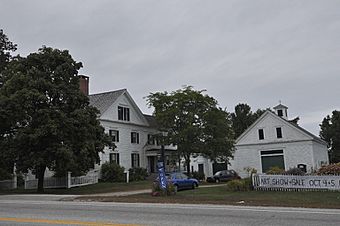Standish Corner Historic District facts for kids
Quick facts for kids |
|
|
Standish Corner Historic District
|
|

The 1789 Marrett House
|
|
| Location | Jct. of ME 25/113 and ME 35, Standish, Maine |
|---|---|
| Area | 8 acres (3.2 ha) |
| Built | 1789 |
| Architectural style | Greek Revival, Federal |
| NRHP reference No. | 93001117 |
| Added to NRHP | October 14, 1993 |
The Standish Corner Historic District is a special place in Standish, Maine. It's home to five old farmhouses that show us what the town looked like a long time ago. These houses were built between the late 1700s and early 1800s. They are all that's left of the very first town center. This historic district was added to the National Register of Historic Places in 1993 because it's so important to history.
Exploring Standish Corner's Past
The town of Standish was first settled by people in the 1760s. It officially became a town in 1785. The town was named after Myles Standish, a famous person from early American history.
How Standish Corner Grew
The very first meeting house (a building for town meetings and church) was built in the Standish Corner area. This spot was a busy crossroads. It was on the main road between Portland and Fryeburg. Because of this, Standish Corner became the center for all the town's early activities.
It was also a place where small businesses operated. There were places that processed animal hides (tanneries). There were also mills that cut wood (lumber mills). Several hotels were also in the area. However, this busy time ended in the late 1800s. A new railway, the Portland and Ogdensburg Railway, was built, but it went around the village. This meant fewer people and businesses came through Standish Corner.
The Historic Houses Today
The five old houses that are still standing from this early time are located along East Ossipee Trail (which is also Route 25/113). They are just south of where it meets Route 35.
The oldest of these five houses was built in 1789. It's called the Marrett House. This house is named after the Marrett family, especially Rev. Daniel Marrett. His family lived there until the early 1900s. After that, it became a historic house museum. Now, you can visit it and learn about history! It's looked after by Historic New England.
Across the street from the Marrett House, you'll find three other houses. They were built in the early 1800s. They show off old building styles like Federal and Greek Revival. North of the Marrett House, right at the main road junction, stands the fifth historic house. It was built in 1793.



